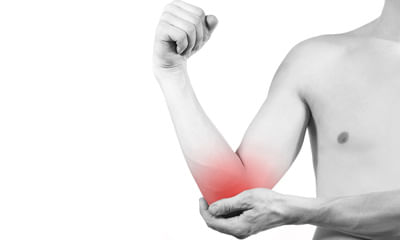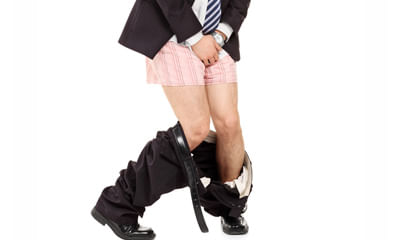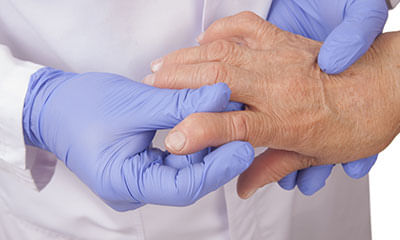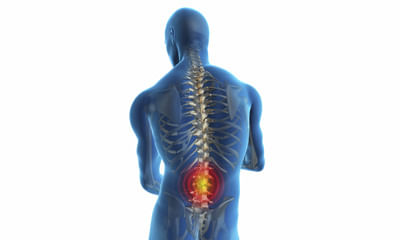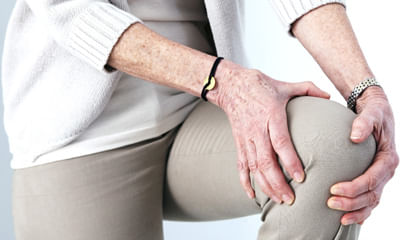How To Reduce Esr In Blood
I am 26 years female, I need urgent advice/solution as I am not able to eat properly since last 3 months. From last four ...
Ask Free Question
Dear lybrate-user please share the diagnosis for which you have been treated. That will help in guiding you take care.
I experience lots of cracking voice in my joints very frequently and I had my few tests done which show 1. Uric acid as ...
Ask Free Question
Treatment goals •to protect the joint from further damages. •provide pin relief. •prevent deformity and disabilities. •increase functional capacity. •improve flexibility and strength. •encourage regular exercise. •improve general fitness. Physiotherapy modalities - hot/cold applications- electrical stimulation- hydrotherapy and spa therapy rehabilitation treatment technique - rest and splinting - compression gloves - assistive devices and adaptive equipment - massage therapy - therapeutic exercise - patient education assistive devices and adaptive equipment occupational therapy improves functional ability in patients with ra. Occupational therapy interventions such as assistive devices and adaptive equipments have beneficial effects on joint protection and energy conservation in arthritic patients.Assistive devices are used in order to reduce functional deficits, to diminish pain, and to keep patients' independence and self-efficiency. Loading over the hip joint may be reduced by 50% by holding a cane. In fact, most of these instruments are originally designed for patients with neurologic deficits; therefore, certain adaptations may be needed for them to be used in patients with arthritis. Elevated toilet seats, widened gripping handles, arrangements related with bathrooms, etc. Might all facilitate the daily life. The procedures needed to increase compliance of the patient with the environment and to increase functional independence are mainly determined by the occupational therapist. Massage therapy that improves flexibility, enhances a feeling of connection with other treatment modalities, improves general well being, and can help to diminish swelling of inflamed joints. Massage is found to be effective on depression, anxiety, mood, and pain. Therapeutic exercise every joint should be moved in the rom at least once per day in order to prevent contracture. In the case of acutely inflamed joints, isometric exercises provide adequate muscle tone without exacerbation of clinical disease activity. Moderate contractures should be held for 6 seconds and repeated 5–10 times each day. Dynamic exercise therapy in improving joint mobility, muscle strength, aerobic capacity and daily functioning in patients with rheumatoid arthritis (ra). Finally, in chronic stage with inactive arthritis, conditioning exercises such as swimming, walking, and cycling with adequate resting periods are recommended. They increase muscle endurance and aerobic capacity and improve functions of the patient in general, and they also make the patient feel better. Patient education in patients with ra, sociopsychological factors affecting the disease process such as poor social relations, disturbance of communication with the environment, and unhappiness and depression at work are commonly encountered. The treatment of rheumatic diseases should provide education and information to their patients about their condition and the various physical therapy and rehabilitative options that are available to improve their quality of life. Passive treatments for rheumatoid arthritis •cold therapy reduces circulation, which ultimately decreases swelling. For example, a cold compress may be placed on the painful area. •cold therapy in acute phase •dosage 10-20mints/1-2 times a day. •heat therapy eases muscle tension and gets blood to flow more quickly to the painful area. For example, a moist, warm cloth may be used to promote circulation. •heat therapy in chronic phase •dosage 20-30mints/1-2 times a day. •hydrotherapy involves reducing your ra-related pain and other symptoms with water. With hydrotherapy, you will be submerged in warm water to relieve your symptoms. •massage can help reduce muscle tension and promote good circulation. It's also a fantastic way to help you manage stress (especially important for people with rheumatoid arthritis). •transcutaneous electrical nerve stimulation (tens) works by blocking pain signals from getting to your spinal cord. It also helps decrease muscle spasms. •tens short term pain relief (6 to 18 hrs) •ultrasound creates warmth using sound waves, whichenchanes circulation and decreases joint pain, inflammation, and stiffness. Exercise for acute phase: •preformed exercise at least once a day. •general assisted movement through normal range (joint mobilisation). •isometric-“static movements” helps to maintain muscle tone without increasing inflammation. Exercise for the chronic phase: •can progress the above exercise to include use of light resistance. •postural/core stability exercises. •swimming/walking/cycling to maintain cardiovascular fitness. •gentle stretch for areas that become tight, such as knees &calves. Regular exercises: •maintaing muscle strength is important for joint stability & preventing injury. •muscles can become weak following reduced activity. •pain signals from yours nerves and swelling can both inhibits muscles. •muscle length can be affected by prolonged positions immobilization and tightness can limit daily activities. Alternative therapies: •thi chi. •musical therapy. •yoga therapy. •relaxation techniques. •pilates. Active treatments for rheumatoid arthritis •flexibility and strengthening exercises improve your range of motion and help you build muscle strength. Yoga and pilates are flexibility and strengthening exercises. •low-impact aerobic exercise is gentle but effective at helping you manage rheumatoid arthritis symptoms. Light walking is an example of this type of exercise. Your physical therapist will let you know how often to do these exercises. For example, you may need to do a few specific exercises 3 times a day, or your physical therapist may recommend a routine that incorporates 30 minutes of low-impact aerobic exercise a day and 30 minutes of strengthening exercises every other day. If your pain is more in the proximal joints, ie. In the upper limbs if the pain is present in the fingers/wrist and in the lower limbs it the pain is present in the toes/ ankle, then we shall definitely say it is rheumatic arthritis. Wear elbow brace and wrist brace which will make her to feel warm and that will make the joints become firm. Hot water fermentation will helpknee cap will also help to prevent the damaged cartilagesif your pain is more in the distal joints, ie. In the upper limbs if the pain is present in the fingers/wrist and in the lower limbs it the pain is present in the toes/ ankle, then we shall definitely say it is rheumatic arthritis. If your proximal joints (ie. Shoulder, hip & knee has pain) then you can pour hot (warm) water in that area to reduce the inflammation. If you have pain in the distal joints ie. Wrist, fingers, ankle, toes then you can wear either elbow brace or wrist brace which will help you to feel warm and very protective. And also immerse the distal joints in the hot water tub which will help you to reduce the pain.
I am 21 years old. Sometimes in the evening my temperature rises to 99.4 then reduces. I feel no fever. What should I do ...
Ask Free Question
Evening rise of temperature be 1 degree fahrenheit is normal. It is physiological. No need to worry.
From 2 weeks I am urinating more then usual 10 12 times day I have 332 sugar which I diagnosed 2 days back after full bo ...
Ask Free Question
Hey you have polyuria which is a symptom of diabetes. So youâve to keep check on your blood sugar levels, fasting levels should be aro 126. Also add hba1c in your investigation. And oral hypoglycaemic drugs are to be taken. You may consult me for if you have any query.
My mother is 54 year old and has been diagnosed with rheumatoid arthritis in joints (knee, hands) 2 years back. She was ...
Ask Free Question
Mostly looks like advanced stage of rheumatoid arthritis. We need to investigate before restarting ra medications. So check her hb, tc,dc, esr,platelets, rft ,sgot, sgpt and update us the results.
I have had pcl reconstruction surgery on 30th jan, followed by knee debridement and lavage on 26th feb due to consistent ...
Ask Free Question
Dear , greetings description tells me that you might have sub-clinical infection. As you are off antibiotics now, we need to see how your feels after 2-3 wks. Repeat your crp and esr levels. 20 days post surgery there should not be any other cause of fever even though its mild. Swelling will take long time to around 6 months or so. Your doctor may advice culture from knee fluid once your are off antibiotics for about 2 wks. Was the second mri with contrast? You have more pain in bone (distal femur or proximal tibia) or the joint itself? Usually infection is rare in arthroscopic procedure as its always under sterile water wash, but it may happen. All I can say as of now is to wait and see what signal your knee gives at 2wks off antibiotics. I hope that helps. You can ping me privately in case you need any clarification. Dr. pratyush gupta m.b.b.s. M.s. Orthopaedics sr consultant indore #bestorthopedicsurgeon #kneereplacement #hipreplacement #microplasty #discprolapse #ligamentinjury #backpain #shoulderpain #elbowpain.
I have undergone a blood overall checkup yesterday and found hba1c 6.w, fasting 102, pp 98. Am already taking 500 mg sug ...
Ask Free Question
Hello, Thanks for the query. Hello, Thanks for the query. I have seen the details given. Present HbA1c% shows you have excellent control. However, please tell me when the treatment was advised what were the FBG & PP glucose levels & HbA1c%? One more important factor is regarding your body weight. Please tell me whether the height mentioned as 4.2 feet is it correct? Because looking at that height you are mrbidly obese with a BMI (Body Mass Index) of 48.35 kgs/Sq meter. At that height your weight should be about 38 kgs, which means thee is an excess of 40 kgs which more than double of your ideal weight. This has to be corrected. Even if you loose 10 kgs your blood glucose will return o normal. Thanks.
I am 28 years old male. I don't remember when I last checked my weight. But I think its been 1 year. When I checked the ...
Ask Free Question
As your test reports are normal. So no need to worry. Follow this 1. Don't take tea empty stomach. Eat something like a banana (if you are not diabetic) or any seasonal fruit or soaked almonds and a glass of water first thing in the morning (within 10 mins of waking up). No only biscuits or rusk will not do. 2. Don't overeat 3. Take your breakfast every day. Don't skip it. U should eat whatever your mother or grandparent eat in bfast. I mean to say whatever is your traditional food. If punjabi eat paratha, if belongs to south then take idli/ dosa etc. 4. Have light meals every 2 hours (in addition to your breakfast, lunch n dinner) e.g. Nariyal paani, chaach, a handful of dry fruits, a handful of peanuts, any fresh n seasonal fruit, a cup of curd/milk etc 5. Finish your dinner at least 2 hours before going to sleep. 6. Maintain active life style7. Avoid fast foods, spicy n fried foods, carbonated beverages 8. Take a lot of green vegetables n fruit. 9. Drink lot of water.10. Everyday preferably sleep on same time exercise in the form of yoga, cycling, swimming, gym etc.Till lock down do suryanamaskar every day. for more details, you can consult me.
Hai sir i'm roja 25/f struggled with lower back pain from last 6 months treatment gets from orthopedic surgeon but no us ...
Ask Free Question
The unstable surface that your swiss exercise ball provides can help awaken your deep core stability muscles. Your physiotherapist can advise you specific exercises. Your swiss exercise ball will help to: eliminate your pain improve your muscular endurance and strength attain better posture, balance, body awareness and co-ordination improve your balance and flexibility learn to lift properly enjoy a low impact aerobic workout posture supportspoor sitting posture is a common cause of sciatica. To assist the support of your lower back many simple and effective products have been developed over time. These include: lumbar d-roll bassett frame kinesiology lumbar tape please ask your physiotherapist for their advice in what will help you most. Exercise sciatic nerve pain 1. Reclining pigeon posepigeon pose is a common yoga pose. It works to open the hips. There are multiple versions of this stretch. The first is a starting version known as the reclining pigeon pose. If you are just starting your treatment, you should try the reclining pose first. 1.While on your back, bring your right leg up to a right angle. Clasp both hands behind the thigh, locking your fingers. 2.Lift your left leg and place your right on top of the left knee. 3.Hold the position for a moment. This helps stretch the tiny piriformis muscle, which sometimes becomes inflamed and presses against the sciatic nerve, causing pain. 4.Do the same exercise with the other leg. Once you can do the reclining version without pain, work with your physical therapist on the sitting and forward versions of pigeon pose. 2. Sitting pigeon pose 1.Sit on the floor with your legs stretched out straight in front of you. 2.Bend your right leg, putting your right ankle on top of the left knee. 3.Lean forward and allow your upper body to reach toward your thigh. 4.Hold for 15 to 30 seconds. This stretches the glutes and lower back. 5.Repeat on the other side. 3. Forward pigeon pose 1.Kneel on the floor on all fours. 2.Pick up your right leg and move it forward on the ground in front of your body. Your lower leg should be on the ground, horizontal to the body. Your right foot should be in front of your right knee while your right knee stays to the right. 3.Stretch the left leg out all the way behind you on the floor, with the top of the foot on the ground and toes pointing back. 4.Shift your body weight gradually from your arms to your legs so that your legs are supporting your weight. Sit up straight with your hands on either side of your legs. 5.Take a deep breath. While exhaling, lean your upper body forward over your front leg. Support your weight with your arms as much as possible. 6.Repeat on the other side. 4. Knee to opposite shoulder this simple stretch helps relieve sciatica pain by loosening your gluteal and piriformis muscles, which can become inflamed and press against the sciatic nerve. 1.Lie on your back with your legs extended and your feet flexed upward. 2.Bend your right leg and clasp your hands around the knee. 3.Gently pull your right leg across your body toward your left shoulder. Hold it there for 30 seconds. Remember to pull your knee only as far as it will comfortably go. You should feel a relieving stretch in your muscle, not pain. 4.Push your knee so your leg returns to its starting position. 5.Repeat for a total of 3 reps, and then switch legs. 5.sitting spinal stretch sciatica pain is triggered when vertebrae in the spine compress. This stretch helps create space in the spine to relieve pressure on the sciatic nerve. 1.Sit on the ground with your legs extended straight out with your feet flexed upward. 2.Bend your right knee and place your foot flat on the floor on the outside of your opposite knee. 3.Place your left elbow on the outside of your right knee to help you gently turn your body toward the right. 4.Hold for 30 seconds and repeat three times, then switch sides. 6. Standing hamstring stretch this stretch can help ease pain and tightness in the hamstring caused by sciatica. 1.Place your right foot on an elevated surface at or below your hip level. This could be a chair, ottoman, or step on a staircase. Flex your foot so your toes and leg are straight. If your knee tends to hyperextend, keep a slight bend in it. 2.Bend your body forward slightly toward your foot. The further you go, the deeper the stretch. Do not push so far that you feel pain. 3.Release the hip of your raised leg downward as opposed to lifting it up. If you need help easing your hip down, loop a yoga strap or long exercise band over your right thigh and under your left foot. 4.Hold for at least 30 seconds, and then repeat on the other sideif you have low back pain and sciatica you can undergo intermittent pelvic traction where in your half of your body weight will be added in the electronic traction so that that would help you to reduce the pain, along with interferential therapy stimulations which would help you to get relieved from the radiating pain. Apply ice for the pain to get subsided immediately. If you cannot go immediately for the physiotherapy treatment. Ice can be kept in the low back where you have back pain. It is suggestible to wear lumbo sacral belt which would help you to build the abdominal muscle tone which itself would make you feel better. You can also wear mcr chappals which would help you to have less weight falling in the painful back. U have to take vitamin d rich foods. Like milk, cheese,yogurt, brocoli,spinach. U need calcium consumption for increase the bone density. Lack of bone and bones crush inside the body this might be due to low calcium or vitamin d which has more impact on the bone density and also it makes one to feel that there is lack of bone strength or in a way the bones are brittle and almost breaking and they feel it is crushed in a way there are many bones breaking at the same time. You have to take vitamin d rich foods. Like milk, cheese,yogurt, brocoli, spinach.u need calcium consumption for increase the bone density. vitamin d intake via supplements or exposure to low levels of sunlight. Vitamin d is used to absorb calcium in the bone and regulate calcium in the blood.
I am 49 years old housewife, my both knees starts paining if I walk more than 15 mts and I have notice that due to pain ...
Ask Free Question
Symptoms of osteoarthritis may include joint pain and progressive stiffness that develops gradualy. Symptoms of rheumatoid arthritis may include painful swelling, inflammation, and stiffness in the fingers, arms, legs, and wrists occurring in the same joints on both sides of the body, especially upon waking up in the morning. You can go for basic blood test where your esr will become increased which itself will show the inflammation.


